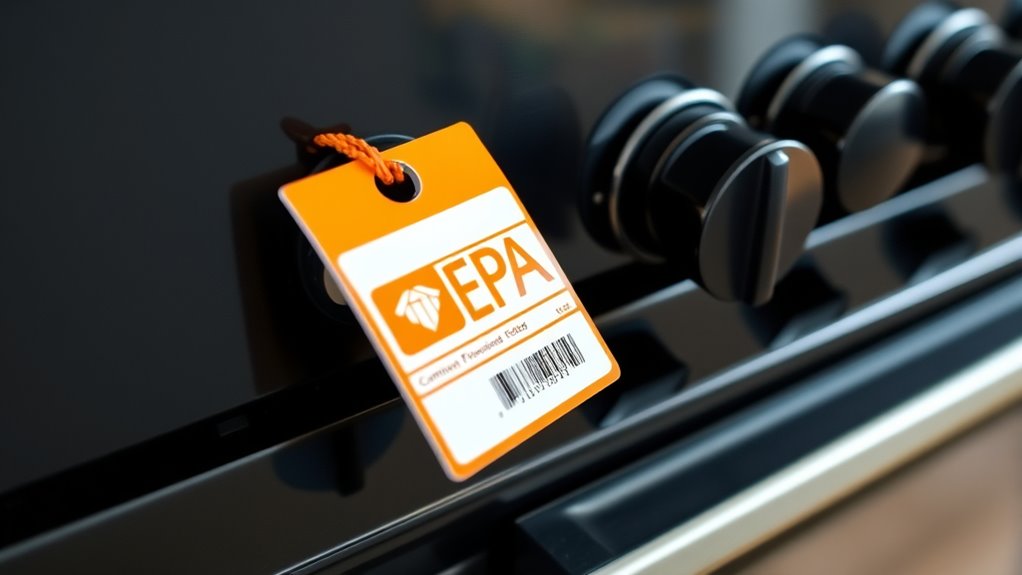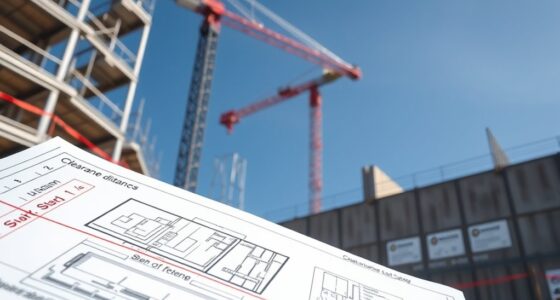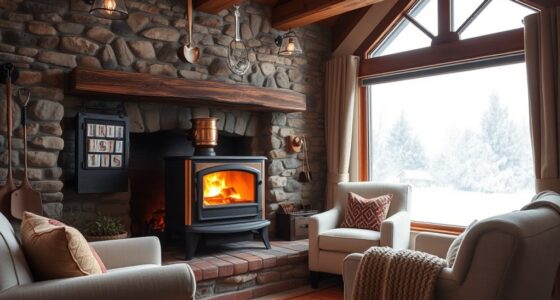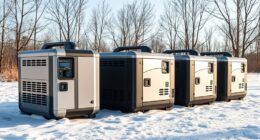When choosing an EPA-certified stove, focus on the label that shows the certification number, emission ratings, and efficiency percentage. Lower particulate emissions mean cleaner burning and better indoor air quality, while a higher efficiency indicates more effective fuel use. Make sure the stove meets safety and ventilation standards for your space. If you’re curious about understanding these labels better, there’s more to discover about selecting the best, eco-friendly stove for your needs.
Key Takeaways
- Check the EPA certification number on the label to verify EPA approval.
- Review emission ratings to assess the stove’s environmental impact; lower particulate numbers indicate cleaner burning.
- Examine the efficiency percentage to compare fuel-to-heat conversion rates among models.
- Look for labels indicating compliance with emission and efficiency standards for reliability.
- Ensure installation instructions and ventilation requirements are clearly specified on the label.
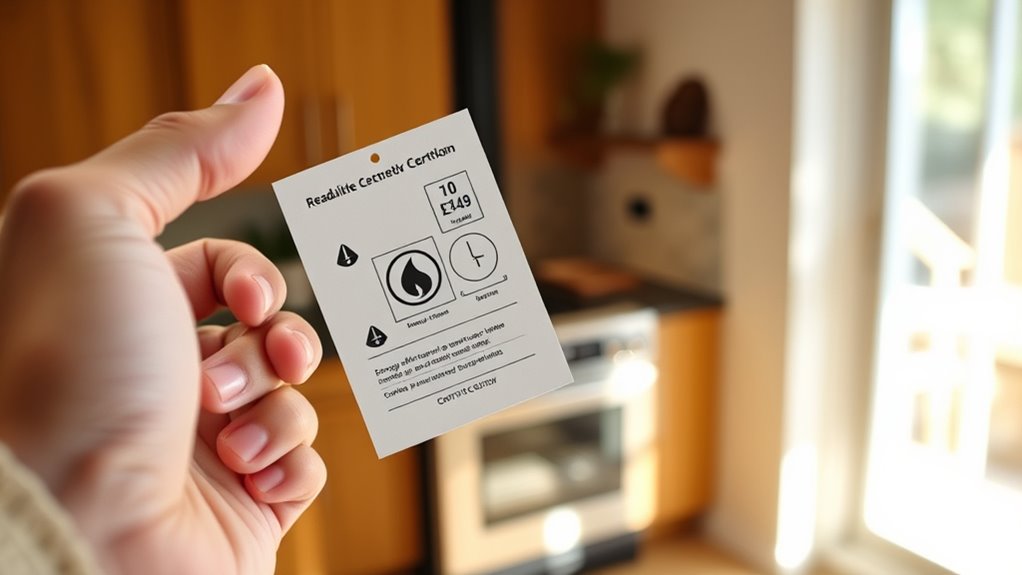
When selecting an EPA‑certified stove, choosing an EPA‑certified model guarantees you get a product that meets strict environmental standards and operates efficiently. But beyond the certification label, understanding how to read the stove’s tag is essential. The EPA label provides key information about the stove’s emissions and efficiency, helping you make an informed decision. It’s important to look for the certification number and emission ratings, which indicate how environmentally friendly and energy-efficient the unit is. A lower particulate emission number means cleaner burning, which benefits both your indoor air quality and the environment. Additionally, the efficiency percentage tells you how well the stove converts fuel into heat, allowing you to compare models for better energy savings.
Once you’ve chosen an EPA-certified stove, proper installation becomes critical. Stove installation tips include paying close attention to ventilation requirements. Good ventilation ensures that any combustion byproducts, such as smoke or gases, are safely vented outside, reducing health risks and maintaining indoor air quality. Before installing, review the manufacturer’s instructions carefully, especially regarding venting options and necessary clearances. You’ll want to verify your stove is installed on a non-combustible surface and that there’s adequate space around it to prevent overheating or fire hazards. Proper clearance is often specified in the installation manual and varies depending on the stove’s size and model.
In addition, understanding stove safety standards can help prevent installation errors that might compromise safety or performance. Ventilation requirements differ among models, so it’s important to determine whether your stove needs a dedicated chimney, a stovepipe, or an outdoor venting system. Some EPA-certified stoves are designed for direct venting, which can be more flexible in tight spaces. When planning your stove installation, consider the existing chimney or venting infrastructure. If you’re installing a new system, you might need to consult with a professional to ensure compliance with local building codes and safety standards. This way, you avoid common mistakes like improper vent placement or insufficient venting capacity, which can cause poor combustion, increased emissions, or even dangerous carbon monoxide buildup.
Frequently Asked Questions
How Often Should I Replace My Epa-Certified Stove?
You should consider replacing your EPA-certified stove when it reaches the end of its typical lifespan, usually around 15-20 years depending on usage and maintenance. Regularly check for signs of inefficiency or damage, and don’t wait until it’s completely worn out. The replacement frequency varies based on how well you care for it, but staying attentive to performance issues ensures you get the most efficient and safe operation from your stove.
Are There Different EPA Certifications for Indoor and Outdoor Stoves?
Think of EPA certifications like different passports for indoor versus outdoor stoves. Yes, there are distinct certification standards because indoor stoves must meet stricter emissions requirements, much like a passport for a different country. Outdoor stoves have their own standards tailored to their use environment. Always check the tag to guarantee your stove’s certification matches its intended setting, ensuring safety and efficiency wherever you install it.
What Maintenance Is Required to Keep My Stove Epa-Certified?
To keep your EPA-certified stove compliant, you should regularly perform chimney cleaning to prevent buildup and guarantee efficient operation. Also, dispose of ashes properly, avoiding excessive accumulation that could hinder performance or safety. Check seals and gaskets periodically, and follow the manufacturer’s maintenance guidelines. Staying on top of these tasks helps maintain your stove’s EPA certification, improves safety, and assures ideal heat output.
Can I Use Non-Certified Stoves in the Same Space?
You shouldn’t use non-certified stoves in the same space as EPA-certified ones because non-certified stoves pose hazards like higher emissions and unsafe combustion. Certification standards guarantee stoves meet strict environmental and safety criteria, so mixing certified and non-certified appliances can increase risks and reduce overall efficiency. Always choose EPA-certified stoves to protect your health, comply with regulations, and minimize hazards associated with non-certified appliances.
Do Epa-Certified Stoves Qualify for Government Rebates or Incentives?
Like a knight in shining armor, EPA-certified stoves often qualify for rebate eligibility and incentive programs. You should check with local or federal programs, as many offer rebates or incentives for choosing eco-friendly, certified appliances. These programs aim to promote cleaner energy solutions, so selecting an EPA-certified stove can save you money upfront and in the long run. Always verify specific program details to confirm your stove qualifies for the benefits.
Conclusion
When you pick an EPA-certified stove, you’re planting a seed for a cleaner, greener home. Reading the tags might seem like decoding a secret message, but it’s really just your map to making smart, eco-friendly choices. Think of it as opening the treasure chest of energy efficiency and cleaner air. With a little knowledge, you’ll steer your home toward sustainability, turning your space into a gust of fresh air in a world that needs it most.

